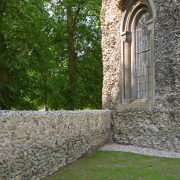Preserving history with funded restoration projects
Safeguarding cultural landmarks plays an instrumental part in the preservation of the nation’s history but the restoration of older buildings often requires a substantial budget. Many iconic buildings have been brought back to life with the support of grant funding, including the National Lottery Heritage Fund that supports architects, historians and property owners who aim to preserve the heritage of noteworthy buildings across the country.
Guardians of heritage
Hundreds of landmarks across the UK have benefitted from National Lottery funding from ancient castles to picturesque estates. Some of these properties are privately owned, like Wentworth Woodhouse, an opulent Georgian building in Yorkshire that was completely restored and is now open to the public.
 At NJ Architects, we have carried out several restoration projects that have been supported by lottery funding, including at The Electric Palace in Harwich, which is one of the oldest working cinemas in the world, first opening its doors on Wednesday 29th November 1911. This Grade II listed building was originally built by travelling showman Charles Thurston and designed by architect Harold Hooper.
At NJ Architects, we have carried out several restoration projects that have been supported by lottery funding, including at The Electric Palace in Harwich, which is one of the oldest working cinemas in the world, first opening its doors on Wednesday 29th November 1911. This Grade II listed building was originally built by travelling showman Charles Thurston and designed by architect Harold Hooper.
The building was closed in 1956 but was later ‘rediscovered’ in 1972 as a derelict shell. Over the last 30 years members of the Electric Palace Trust and volunteers have worked to fully restore a building which occupies a significant place in the history of UK cinema architecture.
Shaun Soanes, Partner at NJ Architects said: “Restoration projects can often be a labour of love, where years of work is spent bringing old exteriors and interiors back to life. Many of these buildings have been subject to weather damage and the structures themselves are ageing, meaning each piece of the building requires meticulous care and attention, to restore its original character”.
A pathway to preservation
For those passionate about safeguarding historical landmarks, applying for National Lottery Heritage Fund support is a meticulous process but an endeavour worth every effort. The fund offers various grant programs tailored to different scales of projects.
To get started it helps to begin by exploring the fund’s website to understand the available grant programs, eligibility criteria and application deadlines involved.
Shaun said: “The early research stages are so important because most grant applications have strict criteria that the build must fulfil to be eligible.
Most funding bodies will expect to see a comprehensive project plan that outlines the scope of restoration, its historical significance, and the intended impact on the community. As part of your application, it helps to show consultations with architects and historians to ensure your project proposal is well-informed and aligned with heritage preservation standards.”
Submission and decisions
Once a compelling application has been written that clearly outlines the importance of your project, its alignment with the fund’s objectives, and the expected outcomes, the submission can be sent to the awarding body.
Shaun said: “Decisions often require deliberation by several different parties so it’s worth moving forward with other plans whilst you wait. Applications undergo a thorough evaluation process and not every request for funding is accepted. But if successful, you will receive the requested funds to start or continue your restoration project”.
Architectural modernisation does not overshadow the merits of older buildings and grant programs like the National Lottery Heritage Fund stand as a guardian of historical landmarks. For all those who share the vision of preserving history for future generations, the fund offers financial aid and exciting opportunities to save buildings that contribute to our rich cultural heritage.





